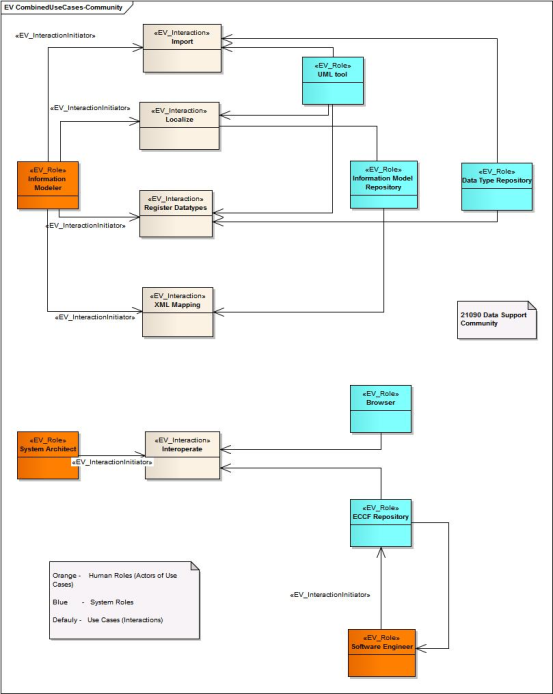This section describes in more detail the links between use cases and the community concept introduced in 4.2 - Relating Use Cases to the ODP Community Concept, by means of the 21090 example.
Recall that each use case represents a fragment of behaviour of a system, defined by the specific triggering action of the primary actor that initiates interactions in order to achieve its own goal.
A complete behaviour of the system with respect to a specific primary actor can be derived by combining all use cases involving the same actor.
Further, an overall behaviour of the system itself can be described by considering all primary actors that interact with the system.
The community concept can be used to describe collaborative structures involving all actors in the interaction with the system (and possibly among themselves). This enables grouping of the related actors and use cases identified in the use case analysis into a collaborative structure that clearly defines boundary of a specific business domain, whether clinical or administrative in nature.
Recall that the community concept essentially provides a formal way of representing collaboration structure reflecting organizational concepts such as roles, processes/interactions (traced back to use cases), business services and policies. The community concept also allows for the description of hierarchical and federated collaborative structures, truly reflecting various organisational and social structuring mechanisms, while supporting downstream software development processes.
Figure 4.4-1 depicts a community model derived by combining use cases and actors from the 21090 datatype support use case discussed in section 3.2 - Use Case Realization.
The <<EV_Role>> stereotype denotes community role (i.e., Enterprise Viewpoint role).
The roles in orange represent community roles to be taken up by people with appropriate position in this community, referred to as 21090 support community. These roles are Information Modeler, Systems Architect, and Software Engineer. These are the roles that are identified taking into account actors in the use cases presented above. The EV_InteractionInitator stereotype indicates the fact that these roles are initiator of interactions.
The roles in blue are roles to be fulfilled by system components, which will provide SI services. These roles are UML model tool, Information Model Repository, Data Type Repository, Browser, and ECCF Repository. The association between these system components and the interactions modelling elements are of the EV_InteractionResponder stereotype, but they are not shown in the figure to reduce clutter.
The invocation of the SI services and the interactions between actors and systems are depicted using the <<EV_Interaction>> stereotype.
The analysis of the related use cases considered in section 3.2 - Use Case Realization led to the identification of two sub-communities of the 21090 datatype support community, depicted in Figure 4.4-1. One sub-community (upper part in the figure) has an objective of providing operational support to the Information Role, while other sub-community has an objective of ensuring tool interoperability via ECCF conformance rules.
Figure 4.4-1 Combining Use Case Models in a Community Model

